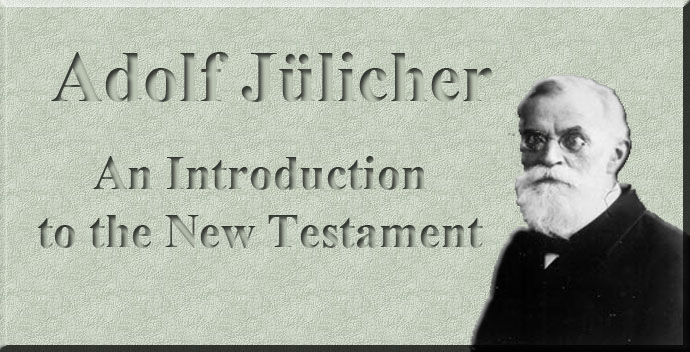
An Introduction to the New Testament
By Adolf Jülicher
PART ONE - Book III
Chapter 1 - Section 23
|
THE FOUR GOSPELS
§ 28. General Remarks on the Gospels 1. For about a hundred years the Gospels according to Matthew, Mark and Luke have been called the Synoptic Gospels in contradistinction to the Gospel according to John, because they stand in such close and at the same time such inextricable mutual relations that a synopsis, i.e. a general view of the whole, is often essential even for a proper understanding of the text, and it is impossible to pass judgment on any one of them without first taking the others into consideration. For comparative study of this kind it is hardly possible to do without a Synopsis which prints the text of the three Evangelists either in parallel columns or else one above the other, so that the reader can embrace the parallel passages at a glance and find the peculiarities of each single Gospel ready divided by external marks from the matter common to the other two or three.
2. In the old tradition the Synoptics and John all bear the same name, Gospel (according to Matthew, Mark etc. κατὰ Ματθαῖον), a name which can hardly date from the writers themselves. In the New Testament, especially in the writings of Paul, the word ʽGospelʼ has the specific meaning of the glad tidings of the fulfilment of all prophecy in Jesus Christ, and of the kingdom he established. Moreover, when Paul speaks of his ʽGospelʼ the word means to him the sum of all that he, as an Apostle, has to communicate, which indeed consisted in ʽChrist alone.ʼ Everyone, however, who gave up his life to the furtherance of this message was an Evangelist. But with Eusebius (about 325 A.D.) ʽEvangelistʼ is the technical name for the writers of the canonical Gospels, of which he speaks in the plural quite fluently, for meanwhileand indeed considerably earlier, in Marcionʼs time, about 140 A.D.ʽGospelʼ had become the term for a certain literary species, le. for the books which told of the Life and Passion and Resurrection of the Lord: Origen (circa 250) speaks without any difference of meaning of the Gospel and the Gospels. These are the books which Justin terms ʽmemoirs of the Apostles,ʼ and Eusebius the ʽDoingsʼ or ʽHistoryʼ of Jesus (αἱ τοῦ Ἰησοῦ πράξεις). The transition from the wider to the more limited interpretation of the word was an easy one; and a lingering sense of the original meaning of the word Gospel a word which demands in reality only one subjective genitive (ʽGodʼsʼ) and one objective genitive (ʽof Jesus Christʼ)can be traced in the fact that the authorsʼ names were not connected with the title by means of the genitive case (as, for instance, the Epistles of Paul), but through the medium of the preposition κατὰ. This formula has ever since been retained in the Latin Bible, either as cata or as secundum, although by about 400 A.D. people had come to talk quite naturally of the ʽEvangelium sancti Lucae.ʼ It would never have occurred to men in those days to argue whether κατὰ Λουκᾶν had from the beginning meant the immediate author, and not merely the authority from whose spoken words the Gospel had been written down by some nameless person, even though κατὰ does in itself admit of different interpretations. 3. The Gospels cannot be called historical books if the term be interpreted as applying solely to books which owe their entire origin either to a mere love of narrative, or to the scientific impulse to recall the past, or to the wish to gain insight into the interdependence of past events and to pass judgment upon them. The same may be said of the Acts. The Gospels were written first and foremost for edification to supply the need of the community which grounded its faith on the words, deeds and sufferings of Jesus, and which could not let the recollection of these thingsthe basis of its existencebe covered up or dimmed. The object of the Gospels was to arouse and keep for ever living the faith in Jesus Christ, to be a substitute for, or perhaps an accompaniment to, the personal preaching of the missionary, and they were also of great use to the primitive Christian in apology and controversy. But they pursued their object through the medium of historical materials, and preserved the narrative form of writing; therefore, in spite of their overwhelming religious tendency, they still have a claim to the title of historical books, at least as much as the books of the Maccabees, and more than the ʽLife of St. Antonyʼ of Athanasius. How far they are trustworthy historical sources is another question, and one to which we shall revert later on. A religious intention must indeed necessarily influence a writerʼs choice of material, but it need not prevent him from telling the truth. Luke certainly claimed to be an historian, and all four Gospels have at least as much right to be included in the literature of history as many a modern ʽLife of Christ.ʼ A. The Synoptic Gospels
|
|
 |
 |
|
|
|
-
Site Navigation
 Home
Home What's New
What's New Bible
Bible Photos
Photos Hiking
Hiking E-Books
E-Books Genealogy
Genealogy Profile
Free Plug-ins You May Need
Profile
Free Plug-ins You May Need
 Get
Java
Get
Java.png) Get Flash
Get Flash Get
7-Zip
Get
7-Zip Get Acrobat Reader
Get Acrobat Reader Get
TheWORD
Get
TheWORD